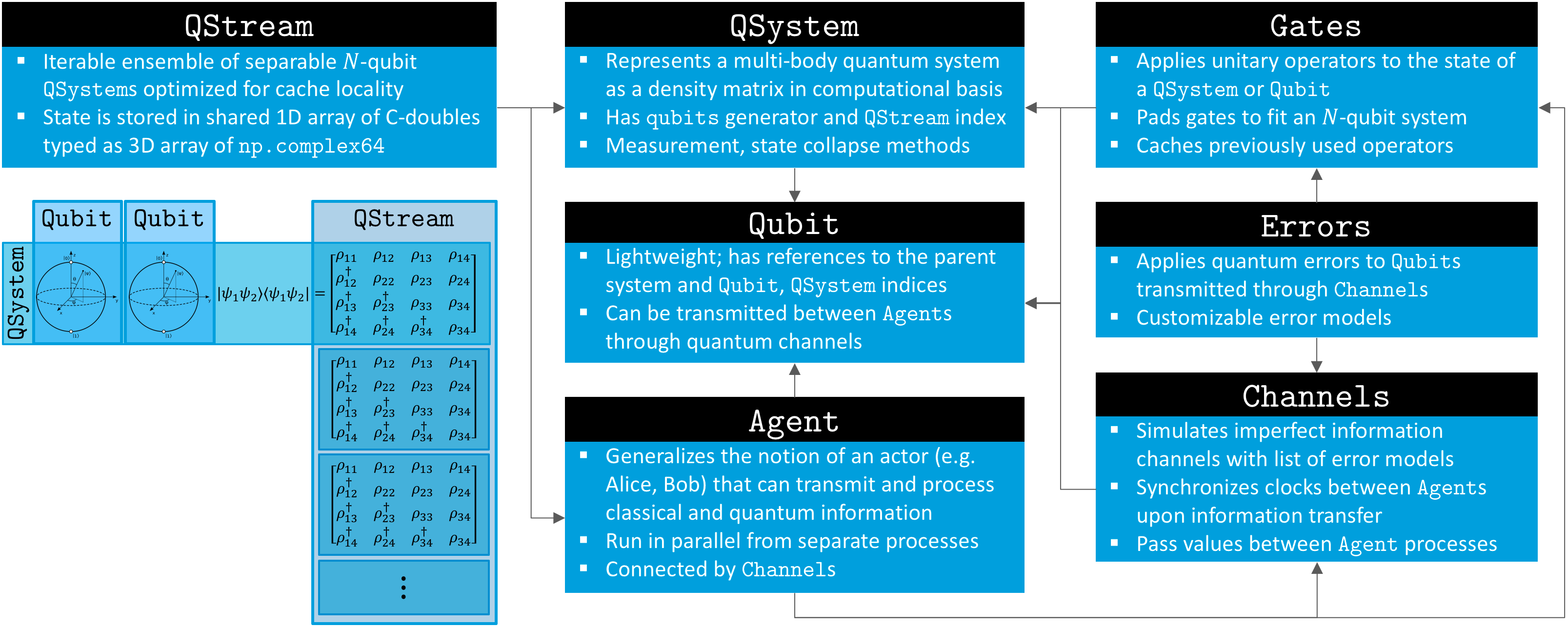# Simulator for quantum networks and channels
<!-- images are hard-linked so they will show up on pypi page -->
The _Simulator for Quantum Networks and Channels_ (`SQUANCH`) is an open-source Python library for creating parallelized simulations of distributed quantum information processing. The framework includes many features of a general-purpose quantum computing simulator, but it is optimized specifically for simulating quantum networks. It includes functionality to allow users to easily design complex multi-party quantum networks, extensible classes for modeling noisy quantum channels, and a multiprocessed NumPy backend for performant simulations.
A schematic overview of the modules available in `SQUANCH` is shown below. (Refer to the [documentation](https://att-innovate.github.io/squanch/) or the [whitepaper](https://arxiv.org/abs/1808.07047) for more details.)

`SQUANCH` is developed as part of the Intelligent Quantum Networks and Technologies ([INQNET](http://inqnet.caltech.edu)) program, a [collaboration](http://about.att.com/story/beyond_quantum_computing.html) between AT&T and the California Institute of Technology.
## Documentation
Documentation for this package is available at the [documentation website](https://att-innovate.github.io/squanch/) or as a [pdf manual](/docs/SQUANCH.pdf). We encourage interested users to read the whitepaper for the `SQUANCH` platform, "A distributed simulation framework for quantum networks and channels" (arXiv: [1808.07047](https://arxiv.org/abs/1808.07047)), which provides an overview of the framework and a primer on quantum information.
## Installation
You can install SQUANCH directly using the Python package manager, `pip`:
```
pip install squanch
```
If you don't have `pip`, you can get it using `easy_install pip`.
## Demonstrations
Demonstrations of various quantum protocols can be found in the [demos](/demos) folder and in the [documentation](https://att-innovate.github.io/squanch/demos.html):
- [Quantum teleportation](https://att-innovate.github.io/squanch/demos/quantum-teleportation.html)
- [Superdense coding](https://att-innovate.github.io/squanch/demos/superdense-coding.html)
- [Man-in-the-middle attack](https://att-innovate.github.io/squanch/demos/man-in-the-middle.html)
- [Quantum error correction](https://att-innovate.github.io/squanch/demos/quantum-error-correction.html)
### Example: quantum interception attack
As an example to put in this readme, let's consider a scenario where Alice wants to send data to Bob. For security, she transmits her message through [quantum superdense coding](https://en.wikipedia.org/wiki/Superdense_coding). In this scenario, shown below as a circuit diagram, we have four [`Agents`](https://att-innovate.github.io/squanch/getting-started.html#using-agents-in-your-simulations), who act as follows:
<img src="https://raw.githubusercontent.com/att-innovate/squanch/master/docs/source/img/man-in-middle-circuit.png" width=500>
- Charlie generates entangled pairs of qubits, which he sends to Alice and Bob.
- Alice receives Charlie's qubit. She encodes two bits of her data in it and sends it Bob.
- Bob receives the qubits from Charlie and Alice. He operates jointly on them and measures them to reconstruct Alice's two bits of information.
- However, the fourth agent, Eve, wants to know Alice's data. She intercepts every qubit Alice sends to Bob, measures it, and re-transmits it to Bob, hoping he won't notice.
An implementation of this scenario in `SQUANCH` is given below.
```python
import numpy as np
import matplotlib.image as image
from squanch import *
class Charlie(Agent):
'''Charlie sends Bell pairs to Alice and Bob'''
def run(self):
for qsys in self.qstream:
a, b = qsys.qubits
H(a)
CNOT(a, b)
self.qsend(alice, a)
self.qsend(bob, b)
class Alice(Agent):
'''Alice tries to send data to Bob, but Eve intercepts'''
def run(self):
for _ in self.qstream:
bit1 = self.data.pop(0)
bit2 = self.data.pop(0)
q = self.qrecv(charlie)
if bit2 == 1: X(q)
if bit1 == 1: Z(q)
# Alice unknowingly sends the qubit to Eve
self.qsend(eve, q)
class Eve(Agent):
'''Eve naively tries to intercept Alice's data'''
def run(self):
bits = []
for _ in self.qstream:
a = self.qrecv(alice)
bits.append(a.measure())
self.qsend(bob, a)
self.output(bits)
class Bob(Agent):
'''Bob receives Eve's intercepted data'''
def run(self):
bits = []
for _ in self.qstream:
a = self.qrecv(eve)
c = self.qrecv(charlie)
CNOT(a, c)
H(a)
bits.extend([a.measure(), c.measure()])
self.output(bits)
# Load Alice's data (an image) and serialize it to a bitstream
img = image.imread("docs/source/img/foundryLogo.bmp")
bitstream = list(np.unpackbits(img))
# Prepare an appropriately sized quantum stream
qstream = QStream(2, int(len(bitstream) / 2))
out = Agent.shared_output()
# Instantiate agents
alice = Alice(qstream, out, data=bitstream)
bob = Bob(qstream, out)
charlie = Charlie(qstream, out)
eve = Eve(qstream, out)
# Connect the agents to form the network
alice.qconnect(bob)
alice.qconnect(eve)
alice.qconnect(charlie)
bob.qconnect(charlie)
bob.qconnect(eve)
# Run the simulation
Simulation(alice, eve, bob, charlie).run()
# Display the images Alice sent, Eve intercepted, and Bob received
# (Plotting code omitted for brevity; results shown below)
```

## Citation
If you are doing research using `SQUANCH`, please cite our whitepaper:
> B. Bartlett, "A distributed simulation framework for quantum networks and channels," arXiv: 1808.07047 [quant-ph], Aug. 2018.




